News
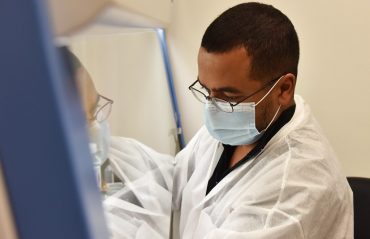
Oct. 19, 2020
Four months in, Baker lab hits the ground running and won’t be stopping anytime soon
Post doctorate Harim Tavares from the Baker lab works in “the hood,” which is a space used to prevent researchers and other outside factors from contaminating cells. By Lauren Hines | Bond LSC Saliva is often something people take for granted. It helps break down food, maintain teeth and keep the oral cavity feeling comfortable. But head and neck cancer patients lose those benefits when chemotherapy treatments damage their salivary glands. Olga Baker set out to research tissue regeneration for these cancer patients by collaborating with the Michael Petris and Gary Weisman labs after setting up…

Oct. 16, 2020
#IAmScience Alana Rodney
By Lauren Hines | Bond LSC Research assistant Alana Rodney walked into her high school science class a few years ago expecting to fill another credit. However, it was there that she found her love of genetics. “I just remember doing the lab and I learned how to use a pipette,” Rodney said. “I was like, ‘Oh, my goodness. This is so cool.’” Fast forward to now and Rodney just completed her undergraduate degree in May 2019. And she’s not stopping there as she now pursues a master’s in animal science, genetics and genomics to…
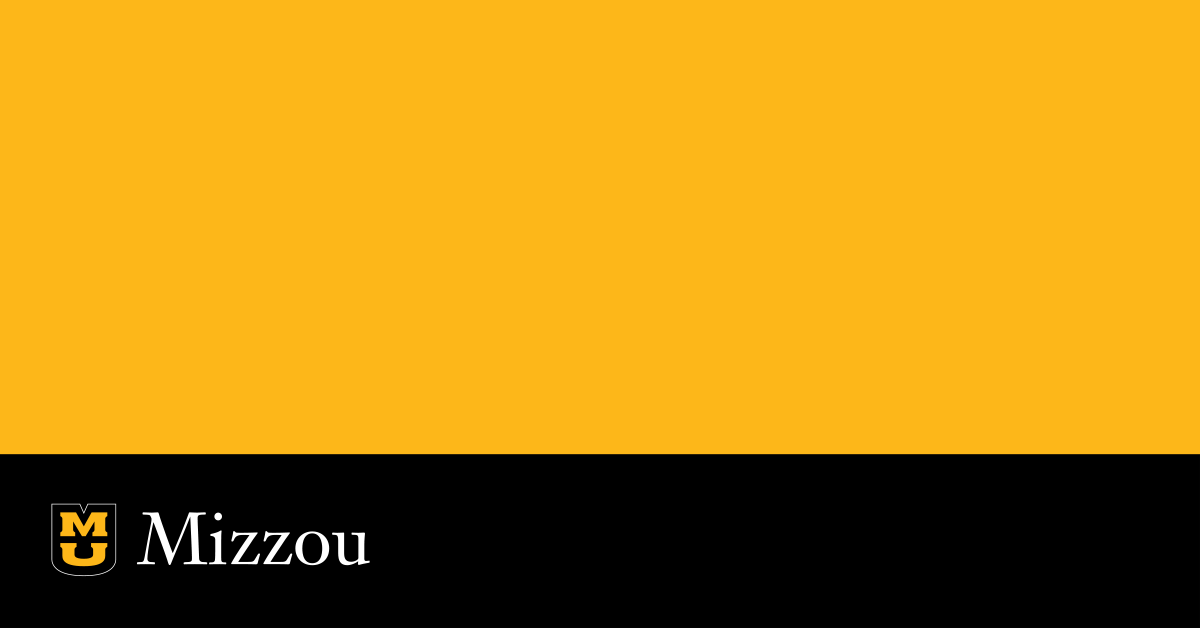
Oct. 14, 2020
Regulators Classify Gene-Edited Rice Varieties with Disease Resistance as Equivalent to Conventional Varieties
Crops resist bacterial leaf blight; ruling clears path to provide smallholder farmers with a safe, affordable option for preventing destructive disease Rice farms in Vietnam. Columbia and St. Louis, MO, October 14, 2020 – The Healthy Crops team, with support from the Bill & Melinda Gates Foundation, have used gene editing tools to develop new varieties of disease-resistant rice that regulators in the United States and Colombia have determined are equivalent to what could be accomplished with conventional breeding. Bacterial blight can reduce rice yields by up to 70 percent, with the heaviest losses typically experienced by smallholder rice…
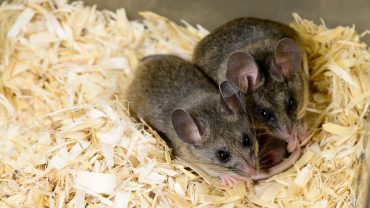
Oct. 12, 2020
Finding a Link between Xenoestrogens and Autism
California mice | photo by Roger Meissen, Bond LSC By Becca Wolf | Bond LSC It’s hard to see a family member treated differently because of a behavior disorder, but those with relatives diagnosed with Autism Spectrum Disorder (ASD) know its impact. Since it affects how people act, communicate, and learn, people with ASD often get bullied or feel left out because of these behaviors. Sarabjit Kaur, a former undergraduate researcher in the Cheryl Rosenfeld lab at the Bond Life Sciences Center, witnessed this stigma firsthand growing up with a brother who is autistic. Going to college, she…
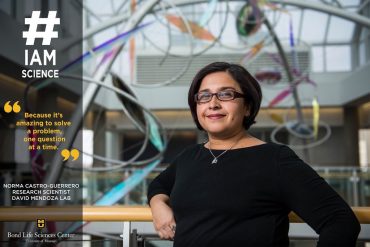
Oct. 9, 2020
#IAmScience Norma Castro-Guerrero
By Becca Wolf | Bond LSC If you like your work, you won’t ever work a day in your life. That’s the case for Norma Castro-Guerrero, a research scientist in David Mendoza’s lab at Bond Life Sciences Center. Having a good attitude and making the most of everything is something she strives to do. “I wake up every day and I am already thinking about what I need to do,” Castro-Guerrero said. “Time flies by during the day. I think that’s a…
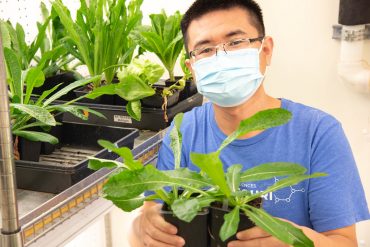
Oct. 7, 2020
Plant vs. Pathogen
Research scientist Jianbin Su studies the immune system in lettuce on the third floor of the Bond Life Science Center. By Lauren Hines | Bond LSC Scientist Jianbin Su’s research lately took him outside to look at patches of grass and cracks in sidewalks around Mizzou’s campus, searching for a subject in the wild. He found his subject in the form of wild lettuce. That search can potentially help Su — a research scientist in the Walter Gassmann lab at Bond Life Sciences Center — better understand the immune system of lettuce and therefore protect it against…
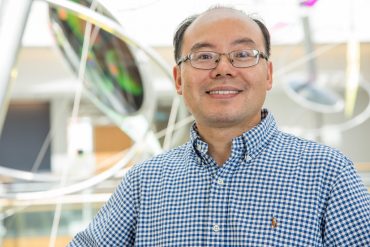
Oct. 5, 2020
Influenza: How it Transmits from Birds to Pigs
Henry Wan | Photo by Roger Meissen, Bond LSC By Becca Wolf Geese will soon fill the skies as they migrate south in V-formation as the weather gets colder and the leaves start changing color. For a month or so, migrating birds take over, crossing roads, sitting in parks and stopping to eat leftover seeds in farm fields or swim in ponds as they travel south for the winter. What people may not realize is that some of these birds are carrying something harmful, yet invisible to the naked eye. That something is influenza A viruses that can…
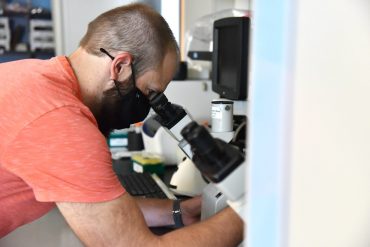
Sep. 25, 2020
Beyond the Vaccine
Lucas Woods from the Weisman lab watches lung cancer cells and oral epithelial cells grow. | photo by Lauren Hines, Bond LSC By Lauren Hines | Bond LSC Vaccine development remains a central goal to get the current COVID-19 pandemic under control. While vaccines are highly vital in the fight against the current pandemic, what if scientists could prevent the virus from entering cells altogether? Researchers at Bond Life Sciences Center are working to do just that and, so far, they’re the only ones at Mizzou on the case. For the Gary Weisman lab, that starts…

Sep. 21, 2020
Four Cell Lines, One Great Discovery
Using cell lines to better understand copper homeostasis Nikita Gudekar working at her lab table. | photo by Becca Wolf, Bond LSC By Becca Wolf | Bond LSC When one thinks of copper, they often think of a shiny new penny. A striking engravement of Abraham Lincoln’s side profile with the words, ‘In God we trust’ engraved over his head. This, however, is not the case for Nikita Gudekar. Gudekar, a genetics area program Ph.D. candidate in the Petris lab, thinks of copper and gets inspired. Copper is an essential element in the body that has many roles…

Sep. 18, 2020
#IAmScience Kinjal Majumder
By Lauren Hines | Bond LSC It was another day in the lab. Kinjal Majumder, a postdoctoral fellow in the David Pintel lab at Bond Life Sciences Center, was working on his research and stopped to check his email. At that moment, he found out he just won a $700,000 grant from the National Institutes of Health. He felt relieved. “I wish I could say something more high minded about it, but honestly, at that point, you’re like, ‘Oh, thank God. I got the award,’” Majumder said. “Then I thought, ‘Alright. I’m gonna…
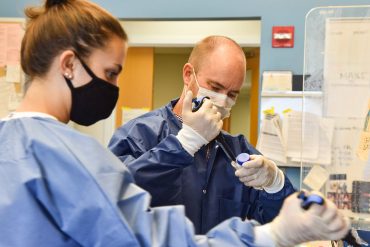
Sep. 11, 2020
A Big Load: Using Wastewater to Test For COVID-19
Marc Johnson collecting pellets in his lab. | photo by Becca Wolf, Bond LSC By Becca Wolf | Bond LSC There is not much thought that goes into using the bathroom. You do your business, flush, and wash your hands. It is just a part of the daily routine. Recently though, human waste has become a golden nugget to researchers. In fact, waste from toilets throughout the community are contributing to figuring out where the next COVID-19 outbreak could happen. And Marc Johnson, Bond Life Sciences Center principal investigator and MU professor of molecular microbiology and immunology, is…

Sep. 4, 2020
Killing Cancer with Code
These maps show the receptors’ locations, density and count in a cancer cell. | photo contributed by Alexander Jurkevich, Donald Burke-Agüero, David Porciani and Skyler Kramer. By Lauren Hines | Bond LSC With two laptops in front of him and a supercomputer on the edge of campus, graduate student Skyler Kramer runs through code daily in the Dong Xu lab with a purpose far beyond deciphering lines of data. He helps his colleagues defeat cancer. Working in Bond LSC with senior post doctorate David Porciani from the Donald…